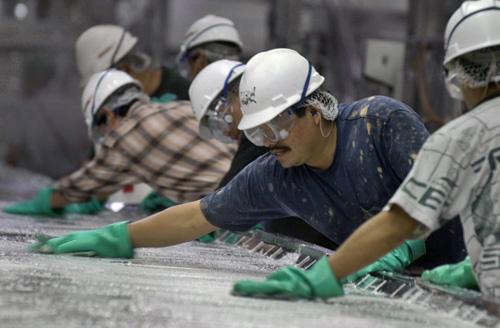Food safety hindered by problems in system

Work surfaces are scrubbed before a shift at the Excel slaughterhouse in Schuyler, Neb., June 7. In the summer months, as many as one in every two cows processed at the Excel plant carry the deadly E. Coli bacteria before being put through steam-pasteuriz Erica Magda
November 6, 2007
OMAHA, Neb. – Peanut butter is regulated by the Food and Drug Administration. But chicken pot pies are the U.S. Department of Agriculture’s responsibility. Frozen cheese pizzas – FDA. But if there’s pepperoni on them, USDA has jurisdiction, too.
Critics of the nation’s food safety system say that it is too fragmented and marked by overlapping authority, and they say that may help explain why dangerous foods keep slipping through and why contamination scares are handled in sometimes inconsistent ways.
“One of the underlying problems is the bifurcation of the regulatory system,” said Caroline Smith DeWaal, director of the Center for Science in the Public Interest’s food safety division.
Critics also complain that the food safety system suffers from a shortage of money and inspectors and inadequate enforcement powers.
In the months ahead, Congress will consider several proposals to reform the system, including creation of a single food safety agency, an idea both the FDA and USDA oppose. A top FDA official said the agencies cooperate well now.
Get The Daily Illini in your inbox!
“We do not believe a single food safety agency would give us the efficiencies you can have from having two agencies responsible for 99 percent of the food that we eat in this country, both domestic and imported,” said Richard Raymond, USDA undersecretary for food safety.
The government structure that protects the food supply took shape piecemeal over the past 101 years. The results could be seen in the way two recalls were handled over the past year.
When Peter Pan peanut butter was linked to a salmonella outbreak in February, ConAgra Foods Inc. recalled it as soon as federal health officials raised questions. But when ConAgra’s Banquet-brand chicken and turkey pot pies were tied to a similar salmonella outbreak in October, the Omaha company waited two days to recall them, first issuing only a consumer health warning.
Peanut butter is regulated by the FDA, while pot pies are regulated by the USDA, because USDA has long had authority over meat and poultry.
Ready-to-eat foods like peanut butter, which is eaten right out of the jar, receive closer scrutiny because there is greater danger if harmful bacteria are present in those foods. Products like pot pies must be cooked first, and proper cooking kills most bacteria.
According to the Centers for Disease Control and Prevention, the pot pies sickened more than 270 people, the peanut butter at least 625.
Neither the FDA nor the USDA had the authority to order ConAgra to recall the products. In fact, all food recalls, except for those involving infant formula, are voluntary. Often, the government gets a product recalled by warning the company it could face bad publicity if it does not withdraw the food.
At least a dozen federal agencies share responsibility for keeping America’s food safe, with the FDA and the USDA’s Food Safety and Inspection Service playing the biggest roles. But none of the agencies use the same rule book.
The USDA and FDA sometimes must inspect the same food plant. For instance, the USDA inspects plants where frozen pepperoni pizza is made, because of the meat topping. But the FDA is responsible for inspecting plants that make frozen cheese pizzas.
In the two ConAgra contamination cases, it turns out that an FDA inspector hadn’t been to the company’s peanut butter plant in Georgia for two years before the recall, while a USDA inspector visits the Missouri pot pie plant daily.






